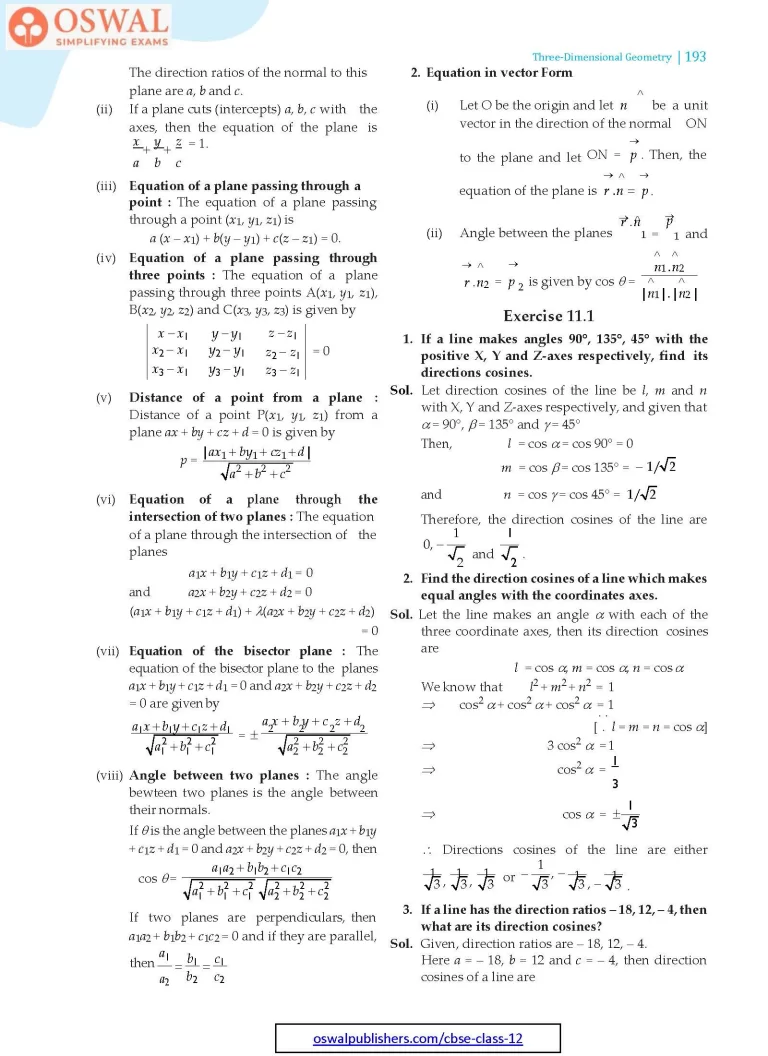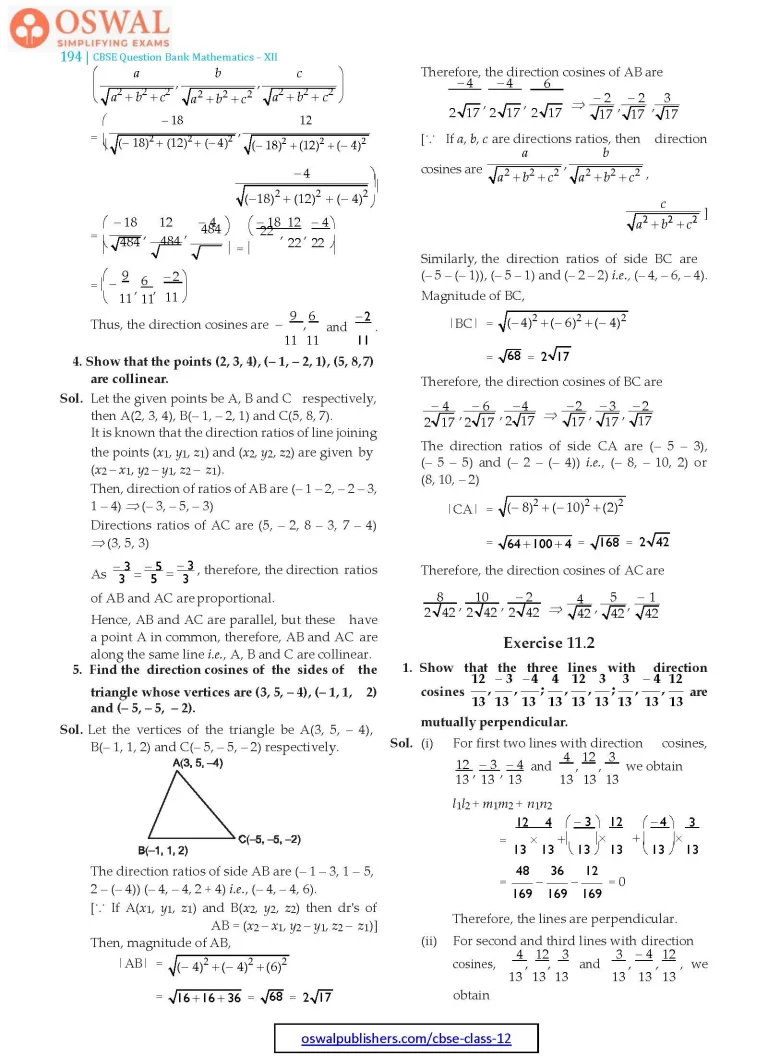NCERT Solutions for Class 12 Maths Chapter 11 - Three-Dimensional Geometry Exercise 11.1


Access Exercises of Class 12 Maths Chapter 11 – Three Dimensional Geometry
Exercise 11.1 Solutions 5 Questions
Exercise 11.2 Solutions 17 Questions
Exercise 11.3 Solutions 14 Questions
Miscellaneous Exercise On Chapter 11 Solutions 23 Questions
Exercise 11.1
1. If a line makes angles 90°, 135°, 45° with the positive X, Y and Z-axes respectively, find its directions cosines.
Sol. Let direction cosines of the line be l, m and n with X, Y and Z-axes respectively, and given that α = 90°, β = 135° and γ = 45°
Then, l = cos α = cos 90° = 0
$$\text{m = cos}\space\beta = \text{cos 135° =}\frac{\normalsize-1}{\sqrt{2}}\\\text{and\space n = cos}\gamma =\text{cos}\space45\degree =\frac{1}{\sqrt{2}}$$
Therefore, the direction cosines of the line are
$$0,-\frac{1}{\sqrt{2}}\text{and}\frac{1}{\sqrt{2}}.$$
2. Find the direction cosines of a line which makes equal angles with the coordinates axes.
Sol. Let the line makes an angle a with each of the three coordinate axes, then its direction cosines are
l = cos α, m = cos α, n = cos α
We know that l2 + m2 + n2 = 1
$$\Rarr\space \text{cos}^{2}\alpha + \text{cos}^{2}\alpha + \text{cos}^{2}\alpha =1\\\lbrack\because\space\text{l=m=n=cos}\space\alpha\rbrack\\\Rarr\space 3\text{cos}^{2}\alpha=1\\\Rarr\space \text{cos}^{2}\alpha =\frac{1}{3}\\\Rarr\space\text{cos}\space\alpha = \pm\frac{1}{\sqrt{3}}$$
∴ Directions cosines of the line are either
$$\frac{1}{\sqrt{3}},\frac{1}{\sqrt{3}},\frac{1}{\sqrt{3}}\space\text{or}\space\frac{1}{\sqrt{3}},-\frac{1}{\sqrt{3}},-\frac{1}{\sqrt{3}}.$$
3. If a line has the direction ratios – 18, 12, – 4, then what are its direction cosines?
Sol. Given, direction ratios are – 18, 12, – 4.
Here a = – 18, b = 12 and c = – 4, then direction cosines of a line are
$$\begin{pmatrix}\frac{a}{\sqrt{a^{2} +b^{2}+c^{2}}},\frac{b}{\sqrt{a^{2}+b^{2}+c^{2}}},\\\frac{c}{\sqrt{a^{2} + b^{2}+ c^{2}}}\end{pmatrix}$$
$$=\begin{pmatrix}\frac{-18}{\sqrt{(-18)^{2}+(12)^{2}+(-4)^{2}}},\frac{12}{\sqrt{(-18)^{2}+(12)^{2}+(-4)^{2}}}\\\frac{-4}{\sqrt{(-18)^{2}+(12)^{2}+(-4)^{2}}}\end{pmatrix}$$
$$=\begin{pmatrix}\frac{-18}{\sqrt{484}},\frac{12}{\sqrt{484}},\frac{-4}{\sqrt{484}}\end{pmatrix}=\\\begin{pmatrix}\frac{-18}{22},\frac{-12}{22},\frac{-4}{22}\end{pmatrix}\\=\begin{pmatrix}-\frac{9}{11},\frac{6}{11},\frac{-2}{11}\end{pmatrix}\\\text{Thus, the direction cosines are}\\-\frac{9}{11},\frac{6}{11}\text{and}\frac{-2}{11}.$$
4. Show that the points (2, 3, 4), (– 1, – 2, 1), (5, 8, 7) are collinear.
Sol. Let the given points be A, B and C respectively, then A(2, 3, 4), B(– 1, – 2, 1) and C(5, 8, 7).
It is known that the direction ratios of line joining the points (x1, y1, z1) and (x2, y2, z2) are given by (x2 – x1, y2 – y1, z2 – z1).
Then, direction of ratios of AB are (– 1 – 2, – 2 – 3, 1 – 4)
⇒ (– 3, – 5, – 3)
Directions ratios of AC are (5, – 2, 8 – 3, 7 – 4)
⇒ (3, 5, 3)
$$\text{As}\space\frac{-3}{5}=\frac{-5}{5}=\frac{-3}{3},\\\text{therefore, the direction ratios}$$
of AB and AC are proportional.
Hence, AB and AC are parallel, but these have a point A in common, therefore, AB and AC are along the same line i.e., A, B and C are collinear.
5. Find the direction cosines of the sides of the triangle whose vertices are (3, 5, – 4), (– 1, 1, 2) and (– 5, – 5, – 2).
Sol. Let the vertices of the triangle be A(3, 5, – 4), B(– 1, 1, 2) and C(– 5, – 5, – 2) respectively.

The direction ratios of side AB are (– 1 – 3, 1 – 5, 2 – (– 4)) (– 4, – 4, 2 + 4) i.e., (– 4, – 4, 6).
[∵ If A(x1, y1, z1) and B(x2, y2, z2) then dr's of AB = (x2 – x1, y2 – y1, z2 – z1)]
Then, magnitude of AB,
$$|\text{AB}| =\sqrt{(-4)^{2} + (-4)^{2} + (6)^{2}}\\=\sqrt{16+16+36}=\sqrt{68}=2\sqrt{17}$$
Therefore, the direction cosines of AB are
$$ \frac{-4}{2\sqrt{17}},\frac{-4}{2\sqrt{17}},\frac{6}{2\sqrt{17}}\\\Rarr\space\frac{-2}{\sqrt{17}},\frac{-2}{\sqrt{17}},\frac{3}{\sqrt{17}}\\\lbrack\because\space\text{If a, b, c are directions ratios,}\\\text{ then direction cosines are}\\\frac{a}{\sqrt{a^{2} + b^{2}+c^{2}}},\frac{b}{\sqrt{a^{2}+b^{2} + c^{2}}},\\\frac{c}{\sqrt{a^{2}+b^{2}+c^{2}}}\rbrack$$
Similarly, the direction ratios of side BC are
(– 5 – (– 1)), (– 5 – 1) and (– 2 – 2) i.e., (– 4, – 6, – 4).
Magnitude of BC,
$$|\text{BC}| = \sqrt{(-4)^{2}+(-6)^{2}+(-4)^{2}}\\=\sqrt{68} =2\sqrt{17}$$
Therefore, the direction cosines of BC are
$$\frac{-4}{2\sqrt{17}},\frac{-6}{2\sqrt{17}},\frac{-4}{2\sqrt{17}}\\\Rarr\space \frac{-2}{\sqrt{17}},\frac{-3}{\sqrt{17}},\frac{-2}{\sqrt{17}}$$
The direction ratios of side CA are (– 5 – 3), (– 5 – 5) and (– 2 – (– 4)) i.e., (– 8, – 10, 2) or (8, 10, – 2)
$$|\text{CA}| ={\sqrt{(-8)^{2} + (-10)^{2} +(2)^{2}}}\\=\sqrt{64+100+4}=\sqrt{168}\\=2\sqrt{42}$$
Therefore, the direction cosines of AC are
$$\frac{8}{2\sqrt{42}},\frac{10}{2\sqrt{42}},\frac{-2}{2\sqrt{42}}\\\Rarr\space \frac{4}{\sqrt{42}},\frac{5}{\sqrt{42}},\frac{-1}{\sqrt{42}}$$
Share page on
NCERT Solutions Class 12 Mathematics
- Chapter 1 Relations and Functions
- Chapter 2 Inverse Trigonometric Functions
- Chapter 3 Matrices
- Chapter 4 Determinants
- Chapter 5 Continuity and Differentiability
- Chapter 6 Application of Derivatives
- Chapter 7 Integrals
- Chapter 8 Applications of the Integrals
- Chapter 9 Differential Equations
- Chapter 10 Vectors
- Chapter 11 Three-Dimensional Geometry
- Chapter 12 Linear Programming
- Chapter 13 Probability
CBSE CLASS 12 NCERT SOLUTIONS
- NCERT Solutions Class 12 English Core
- NCERT Solutions Class 12 Physics
- NCERT Solutions Class 12 Chemistry
- NCERT Solutions Class 12 Biology
- NCERT Solutions Class 12 Business Studies
- NCERT Solutions Class 12 Mathematics
- NCERT Solutions Class 12 Accountancy
- NCERT Solutions Class 12 Economics
- NCERT Solutions Class 12 Geography
- NCERT Solutions Class 12 History
- NCERT Solutions Class 12 Political Science
CBSE CLASS 12 SYLLABUS
- CBSE Class 12 English core Syllabus
- CBSE Class 12 Mathematics Syllabus
- CBSE Class 12 Physics Syllabus
- CBSE Class 12 Chemistry Syllabus
- CBSE Class 12 Biology Syllabus
- CBSE Class 12 Accountancy Syllabus
- CBSE Class 12 Business Studies Syllabus
- CBSE Class 12 Economics Syllabus
- CBSE Class 12 History Syllabus
- CBSE Class 12 Geography Syllabus
- CBSE Class 12 Political science Syllabus
- CBSE Class 12 Sociology Syllabus
- CBSE Class 12 Psychology Syllabus
- CBSE Class 12 Physical education Syllabus
- CBSE Class 12 Applied mathematics Syllabus
- CBSE Class 12 History of Indian Arts Syllabus
CBSE CLASS 12 Notes
- CBSE Class 12 Physics Notes
- CBSE Class 12 Chemistry Notes
- CBSE Class 12 Biology Notes
- CBSE Class 12 Maths Notes
- CBSE Class 12 Accountancy Notes
- CBSE Class 12 Business Studies Notes
- CBSE Class 12 Economics Notes
- CBSE Class 12 History Notes
- CBSE Class 12 Geography Notes
- CBSE Class 12 Political Science Notes
